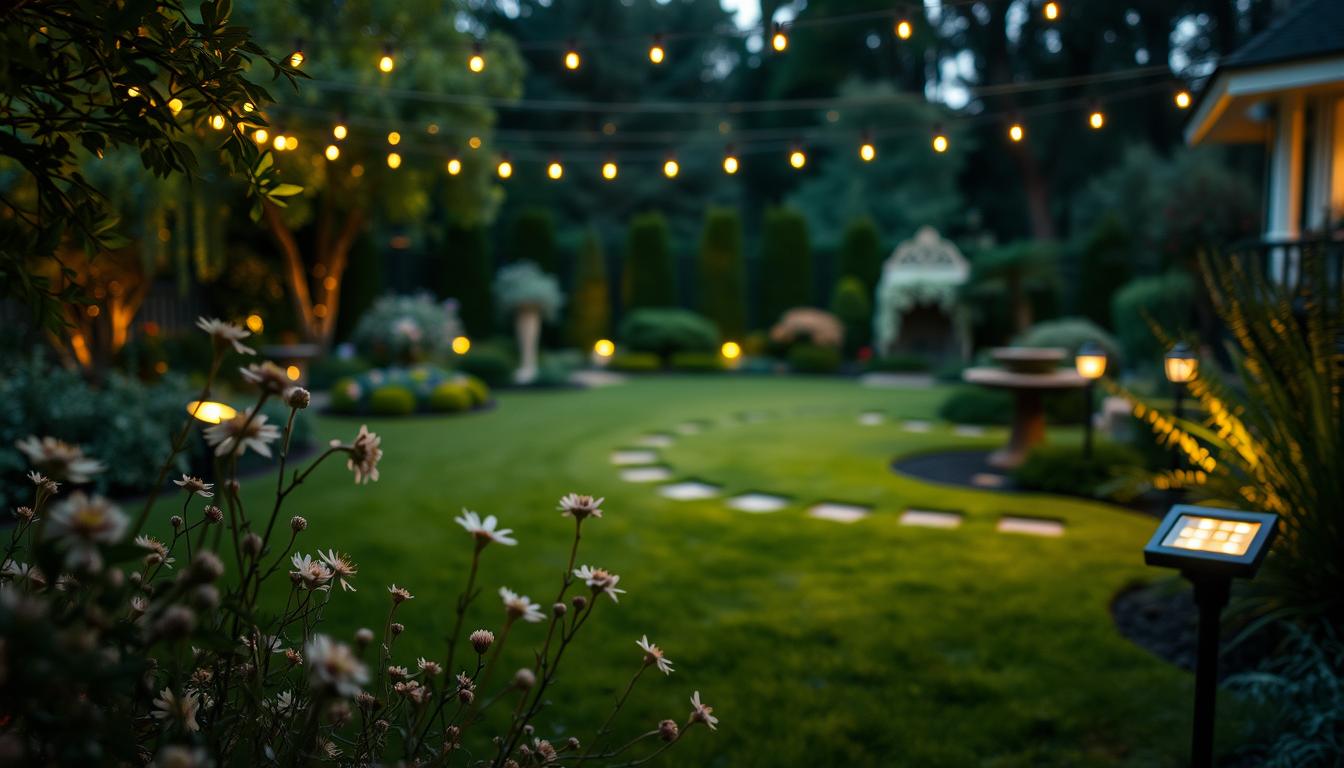Do you remember the days of running extension cords across your lawn? Or dealing with high electric bills to light up your outdoor space? Those days are fading away. Homeowners across America are finding joy in solar-powered garden lights. They turn yards into magical nighttime retreats, without the need for complex wiring or ongoing costs.
I’ve tried many outdoor lighting options over the years. From electric systems to battery-operated ones, nothing beats solar lights. They use the sun’s energy to create a warm glow. This glow enhances security and shows off your landscaping.
These lights also save you money on utility bills. Plus, they add charm and character to your property. Whether you want to light a pathway, highlight garden features, or create evening spaces, this guide has you covered. It will help you choose and install the perfect solar lighting system for your outdoor area.
The Growing Popularity of Eco-Friendly Outdoor Lighting
Solar-powered garden lights have become very popular. Homeowners want green options for their outdoor areas. The solar lighting market in the US has grown by 25% every year since 2018.
People now see solar garden lights as more than just useful. They are seen as a way to show they care about the planet. Social media has helped, with Pinterest and Instagram seeing big increases in posts about solar garden lights.
The Shift Toward Sustainable Garden Solutions
The move to green outdoor spaces started with organic gardening in the early 2000s. People became worried about pesticides. Then, they turned to saving water with drought-resistant plants and rainwater systems.
Now, energy-saving lights are key in this journey. Homeowners want their outdoor areas to be fully eco-friendly. Solar lights are at the heart of this, thanks to stricter energy laws and green living efforts.
Why Homeowners Are Embracing Solar Technology
Solar garden lights offer many benefits. Saving money on electricity is a big reason. A typical home can save $50 to $150 a year with solar lights.
They are also easy to install. Unlike wired lights, solar lights can be set up by anyone in minutes. This is great for DIY projects and new homeowners.
| Year | US Solar Garden Light Market Size | Annual Growth Rate | Top Consumer Motivation |
|---|---|---|---|
| 2018 | $420 million | 18% | Environmental concerns |
| 2019 | $525 million | 22% | Energy savings |
| 2020 | $656 million | 25% | Easy installation |
| 2021 | $820 million | 28% | Aesthetic appeal |
How Solar-powered Garden Lights Actually Work
Solar garden lights use a smart system to turn sunlight into light at night. They have advanced technology that works well for years with little upkeep. Knowing how they work helps you choose the right ones for your garden.
The system has three parts: photovoltaic cells, batteries, and LED bulbs. Let’s look at each part in simple terms.
The Science Behind Photovoltaic Cells
At the core of solar garden lights is a photovoltaic (PV) cell. It’s the same tech used in big solar panels. PV cells use materials like silicon to turn sunlight into electricity.
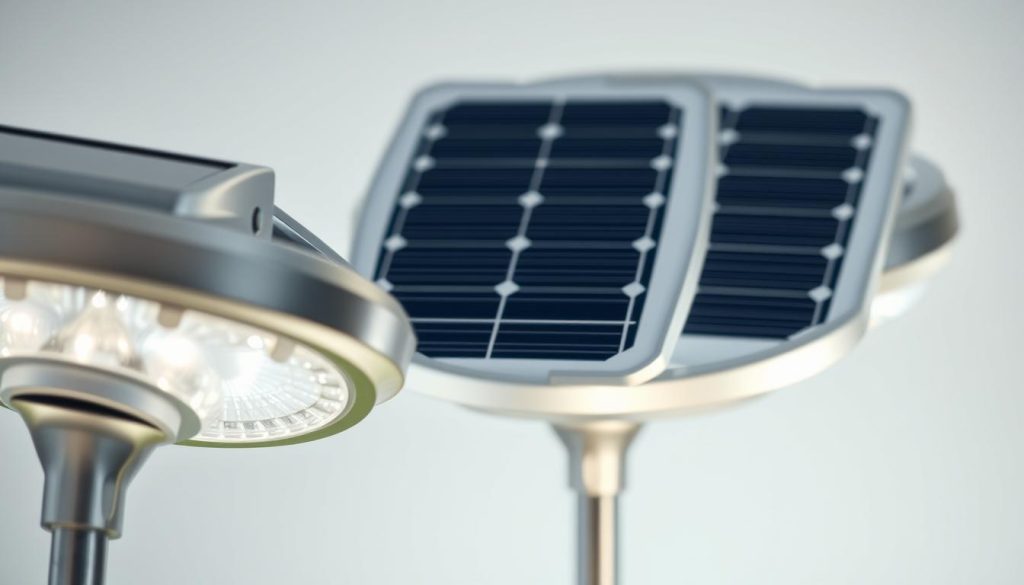
Even on cloudy days, solar cells work well. They don’t need strong sunlight to work. The latest tech can turn 15-22% of sunlight into electricity, enough for garden lights.
The size of the solar panel affects how much energy it can store. Bigger panels mean brighter lights or longer use at night.
Energy Storage and LED Technology
After capturing sunlight, the energy goes to rechargeable batteries. These are usually lithium-ion or NiMH. They store energy for use at night.
A small circuit board with a photoresistor controls the light. It turns on the light when it gets dark. This uses power from the battery.
LEDs are great with solar tech because they’re very efficient. They turn most of their energy into light, unlike old bulbs that waste a lot as heat. This means they use less energy to light up for longer.
Together, photovoltaic cells, batteries, and LEDs make a system that lights up your garden without needing electricity. This green solution turns sunlight into beautiful light at night, without harming the environment.
Environmental Benefits of Choosing Solar Illumination
Using solar lights in your garden cuts down on environmental harm and makes your outdoor area more beautiful. As worries about the climate grow, people are looking for green lighting options. Solar garden lights are a simple yet powerful way to make your garden more sustainable.
Reducing Your Carbon Footprint
Regular outdoor lights use a lot of energy. In the US, homes use about 12% of their electricity for lighting. Most of this is for lights outside. Switching to solar lights means no more energy use.
Electric garden lights can produce up to 40 pounds of carbon dioxide a year. Going solar is like planting 2-3 trees each year. This small change can make a big difference in reducing harmful emissions.
Solar lights work without any grid connection. They use the sun’s energy, which is clean and renewable. This means your garden stays lit without harming the environment.
Eliminating Battery Waste
Solar lights also cut down on battery waste. In the US, over 3 billion batteries are thrown away each year. Many of these end up in landfills, harming soil and water.
Good solar lights use batteries that last 1-2 years. This is much longer than disposable batteries. So, you use about 80% fewer batteries over time.
When solar lights wear out, many makers offer recycling. This way, the parts can be safely reused. Choosing solar lights means you’re choosing to reduce waste and keep your garden beautiful.
Economic Advantages: Saving Money While Beautifying Your Space
Solar garden lights are not just good for the planet. They also save you money. At first, they might seem pricey. But, when you look at the whole picture, they’re a smart choice for those watching their budget.
Let’s dive into the financial side of solar lighting. We’ll see how they compare to traditional lights.
Initial Investment vs. Long-term Savings
At first glance, solar lights might seem more expensive than wired systems. Wired lights can cost $200-$500 for a basic setup. But, professional installation can add $500-$2,000 more. You also have to think about digging trenches and fixing landscapes.
Solar lights, on the other hand, cost between $30-$300 for good quality. High-end models can reach $500. Even though they might seem pricey at first, they save you money on installation. Plus, they last just as long as wired lights, with some lasting 5-10 years.
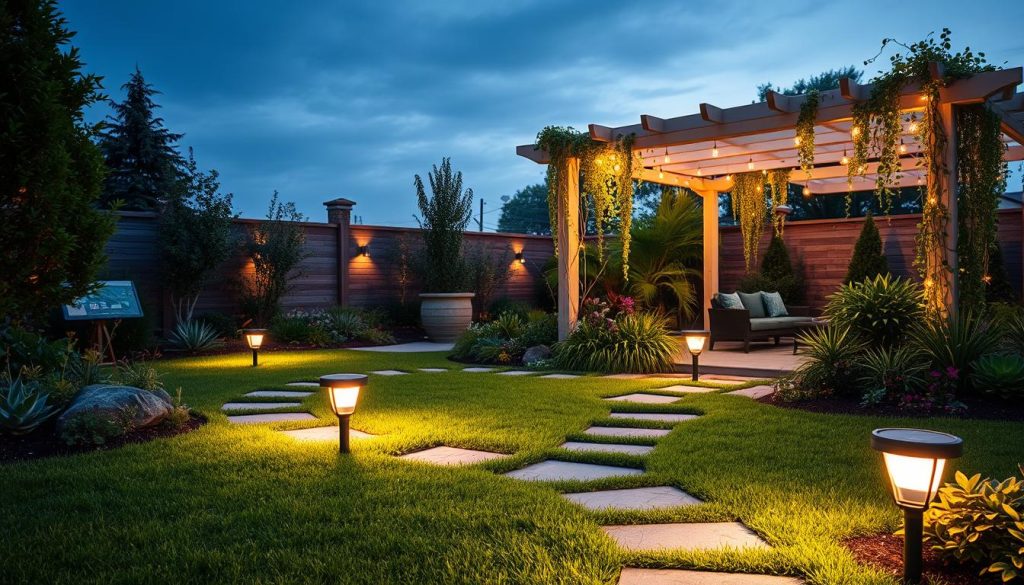
Zero Electricity Costs for Years to Come
The biggest money-saving perk is after you install them. Wired lights can add $10-$40 to your monthly electric bill. Over five years, that’s $600-$2,400. Solar lights don’t have this cost.
Good solar lights pay for themselves in 12-24 months. For example, a small setup of ten 40-watt lights costs about $102 a year. Solar lights save you this money.
Over time, the savings add up. A mid-range solar lighting system pays for itself in two years. Then, it lights your garden for free for years to come. This makes solar lighting a wise choice for saving money and beautifying your garden.
Types of Solar-powered Garden Lights for Every Landscape
Choosing the right solar-powered garden lights is key to enhancing your landscape. There are many types available, each with its own use. Solar garden lights can be sorted by function and design, making it easier to pick the right ones. Let’s look at the most popular types and how they can brighten up your outdoor space using clean solar energy.
Path and Walkway Lights
Path lights are a common and useful choice for gardens. They light up walkways, paths, and driveway edges. These lights are easy to install since they come with stakes that push into soft ground.
The best path lights shine brightly all night. Look for ones with big batteries that hold enough energy during the day. Place them 6-8 feet apart for a soft, even glow.
Many path lights turn on automatically at dusk and off at dawn. When picking path lights, think about how bright they are (in lumens) and how well they can handle the weather.
Best Designs for American Gardens
Solar path lights that match your garden’s style are best for American gardens. Colonial homes look great with copper or black metal lights and clear glass. Southwestern gardens do well with terra cotta or bronze. Modern homes need sleek stainless steel or simple designs.
Accent and Spotlight Options
Solar accent lights and spotlights focus on specific parts of your garden. They highlight trees, water features, and statues. Spotlights are brighter and more focused than path lights.
Spotlights often have adjustable heads and stakes. This lets you play with different lighting effects like uplighting or silhouetting.
For good accent lighting, choose lights with at least 50-100 lumens. Some high-end spotlights have remote solar panels for better placement.
Decorative and String Light Varieties
Decorative solar lights add fun and personality to your garden. They come in lanterns, color-changing orbs, and more. They may not light up much, but they make your garden magical at night.
Solar string lights are great for decorating without needing outlets. They can turn patios and trees into magical places at night. These lights have a separate panel for sun exposure and can be placed anywhere.
When picking decorative lights, match them to your garden’s style. Avoid mixing too many styles. Choose lights that tell a story in your garden.
| Light Type | Best Applications | Typical Brightness | Average Lifespan | Price Range |
|---|---|---|---|---|
| Path Lights | Walkways, garden borders, driveway edges | 5-30 lumens | 2-3 years | $15-$50 per light |
| Spotlights | Trees, statues, architectural features | 50-200 lumens | 3-5 years | $25-$100 per light |
| String Lights | Patios, pergolas, tree canopies | 2-5 lumens per bulb | 1-2 years | $20-$60 per strand |
| Decorative Lights | Garden accents, water features | 5-15 lumens | 1-3 years | $10-$75 per piece |
Strategic Placement: Maximizing Solar Efficiency in Your Yard
To get the most out of your solar lights, know where the sun shines best in your yard. Even top-notch solar lights won’t work well if they’re in the shade. By placing them right, you’ll get brighter lights and they’ll last longer. Plus, your garden will use less energy.
Identifying Optimal Sun Exposure Locations
For solar lights to shine bright, find spots that get lots of direct sunlight. In the Northern Hemisphere, the south side gets the most sun. This means your lights will charge up better and light up your yard longer.
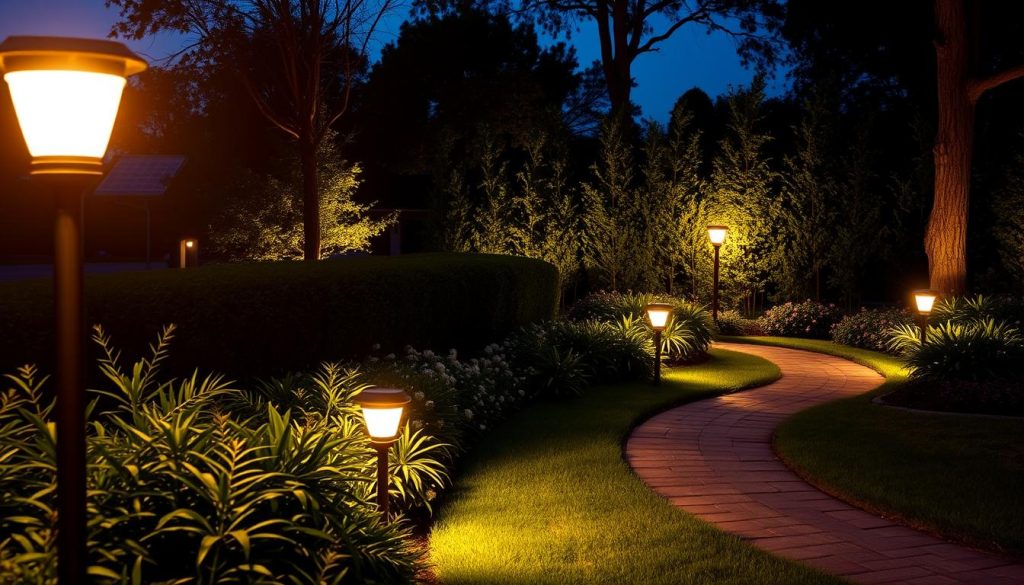
Find the best spots by watching your yard at different times. Morning sun is softer than the afternoon sun, which is better for charging. Watch the sun’s path for a day before you start setting up your lights.
Solar garden lights need 4-6 hours of sun to fully charge. But, some high-end models can charge in just 3-4 hours. Remember, the sun’s path changes with the seasons, so you might need to adjust your lights’ spots.
| Sun Exposure Level | Daily Sunlight Hours | Best Light Types | Expected Performance |
|---|---|---|---|
| Optimal | 6+ hours direct sun | All types, including spotlights | 8-12 hours at full brightness |
| Good | 4-6 hours direct sun | Path lights, accent lights | 6-8 hours at good brightness |
| Moderate | 3-4 hours direct sun | Low-intensity decorative lights | 4-6 hours at reduced brightness |
| Poor | Less than 3 hours | Only specialized low-light models | 2-4 hours at minimal brightness |
Avoiding Shade and Obstruction Issues
Even a little shade can hurt your solar lights’ performance. Things like trees, shrubs, and buildings can block sunlight. Remember, plants grow and change with the seasons, so what’s sunny in winter might be shaded in spring.
Think about how plants will grow and change with the seasons when planning your lights. A small tree can grow and block sunlight to your lights. Deciduous trees let more light in winter but block it in summer.
If you can’t get enough sun, use solar lights with separate panels. These let you place the solar collector in the sun and the light where it’s shadier. This is great for covered areas, dense gardens, or north-facing walls.
For areas with little sun, use solar lights with big panels or high efficiency. These can charge even in less-than-ideal spots. But, they cost more for these special features.
DIY Installation: No Electrician Required
Solar path lights are easy to install without needing an electrician. They’re great for those who want to light up their garden without the cost of hiring a pro. With simple tools and a few steps, you can brighten your garden in just a few hours.
Step-by-Step Installation Process
Setting up solar garden lights is easy if you follow a few steps. First, unpack your lights and make sure everything is there. Most lights are almost ready to go, needing just a little setup.
Let your lights soak up the sun for 8 hours before you start. This makes sure the batteries are charged and all lights work before you put them in your garden.
Walk your garden to find the best spots for your lights. Use flags or stakes to mark these places. Then, remove any debris or plants that might get in the way.
Check the soil where you’ll put your lights. If it’s hard or rocky, you might need to dig holes or soften it with water. For loose soil, think about how to keep the lights steady.
Securing Lights Properly
For stake-style lights, push them into the ground at an angle and then straighten them. This helps them stay stable. But be careful not to push too hard and damage the light or stake.
If you’re dealing with rocky ground, dig small holes first. Or, you can mount lights on decks, fences, or walls with the right hardware. Most lights come with different mounting options for various surfaces.
Tools and Materials You’ll Need
Solar garden lights need very little for installation. You probably have most of what you need in your toolbox. Having the right stuff ready will make the job easier and faster.
For tougher jobs or tricky terrain, some special tools can help. But, you can also use things you have at home if you’re watching your budget.
| Essential Tools | Optional Tools | Materials | Household Alternatives |
|---|---|---|---|
| Garden gloves | Rubber mallet | Solar path lights | Wooden spoon (instead of mallet) |
| Garden trowel | Landscape marking paint | Landscape fabric (for weed prevention) | Kitchen spoon (instead of trowel) |
| Tape measure | Level | Decorative rocks (for stability) | String and ruler (instead of tape measure) |
| Screwdriver set | Pruning shears | Outdoor mounting tape/hardware | Butter knife (instead of screwdriver) |
Weatherproofing Considerations for Year-Round Performance
From scorching summers to freezing winters, it’s key to weatherproof your solar garden lights. The quality of your outdoor lighting depends on its construction and materials. Knowing how to pick and care for the right fixtures keeps your garden lit all year.
Choosing Lights for Your Climate
When buying solar garden lights, check the IP (Ingress Protection) rating. This code shows how well the light can handle the weather. For example, an IP65 rating means it’s dust-tight and can handle water jets, great for most homes.
In coastal areas with hurricanes, look for IP67 or higher ratings. These lights can handle being underwater briefly. In snowy northern states, choose lights with strong solar panels that can handle snow and cold. For sunny southwestern homes, pick lights with UV-resistant materials to avoid damage.
The material of the housing is also important. High-quality ABS plastic or stainless steel lasts longer than basic plastic. Some lights even have special coatings to fight corrosion in humid places.
Seasonal Maintenance Tips
Keep your solar lights in top shape with a simple maintenance routine. In spring, clean pollen and dust from the solar panels with a soft cloth and soap. This can boost charging by up to 25%.
In summer, check for insect nests in vents or wiring. A quick check can stop short circuits or blockages. In fall, remove leaves and debris to keep solar panels clear.
Winter maintenance is crucial – clear snow from solar panels within 24 hours. In very cold areas, bring portable lights inside during bad weather. Some people switch their lights for summer and winter.
Most maintenance tasks only take a few minutes but can extend your lights’ life by years. With the right care and climate choice, your solar garden lights will shine through every season.
Solar-powered Garden Lights: My Top Recommendations
I’ve installed many solar garden lights in different places. I’m excited to share my top picks that are both functional and beautiful. These lights have passed the test of changing seasons and weather.
Best Budget-Friendly Options
You don’t have to spend a lot to get good solar lighting for outdoors. In the $15-30 range, you can find durable lights that shine all night.
Look for lights that last 8-10 hours and are weather-proof. Many affordable lights now have adjustable brightness and warm white LEDs. These features make your garden feel welcoming.
- Stake lights with stainless steel construction offer the best durability-to-price ratio
- Path lights with frosted plastic diffusers provide more even illumination
- String lights with replaceable batteries extend the product lifespan significantly
- Solar spotlights with adjustable panels capture more sunlight in partially shaded areas
For the best value, consider multipacks. They let you light up a whole pathway for under $50.
Premium Picks for Discerning Homeowners
If you want to make a statement with your lighting, look at premium options. These lights cost between $50-150 and offer big benefits. They have larger solar panels, better energy conversion, and last longer.
Premium lights use weather-resistant metals like copper and brass. They also adjust brightness and can detect motion. This makes them stand out.
What sets premium lights apart is their long life. They come with 2-5 year warranties, unlike budget lights’ 90-day guarantee. After a year, premium lights still work great, while budget ones may not.
Most Innovative Designs on the Market
The solar lighting world is always getting new and exciting. Now, you can control your lights with your phone, without any wires. This is thanks to smart solar lights.
There are also lights that change color and move like fireflies. Some even use wind turbines to keep shining on cloudy days. These lights add fun and wonder to your garden.
My favorite new thing is lights that mimic nature. Like firefly jars that twinkle or pool lights that change with water movement. These lights are not only fun but also eco-friendly.
Enhancing Home Security with Strategic Solar Lighting
Adding solar-powered lighting to your outdoor space boosts home security. Many choose solar lights for their eco-friendliness and cost-effectiveness. But, they also play a key role in protecting your home. Experts say homes with bright exteriors see up to 39% fewer break-ins than dark ones.
Solar lights offer a smart way to mix security with green living.
Deterring Intruders with Illuminated Pathways
A dark home looks empty to intruders. Solar lights along walkways, driveways, and entrances make it seem occupied. This simple trick deters intruders by removing hiding spots.
Focus on these areas for the best security:
- Main entry points like front doors and garage doors
- Property boundaries and fence lines
- Dark corners and alcoves around the home
- Paths leading to and from the street
Even simple solar path lights can make your property more visible. Use brighter lights (100+ lumens) at entry points and softer ones for decoration. This way, you keep your garden looking good while boosting safety.
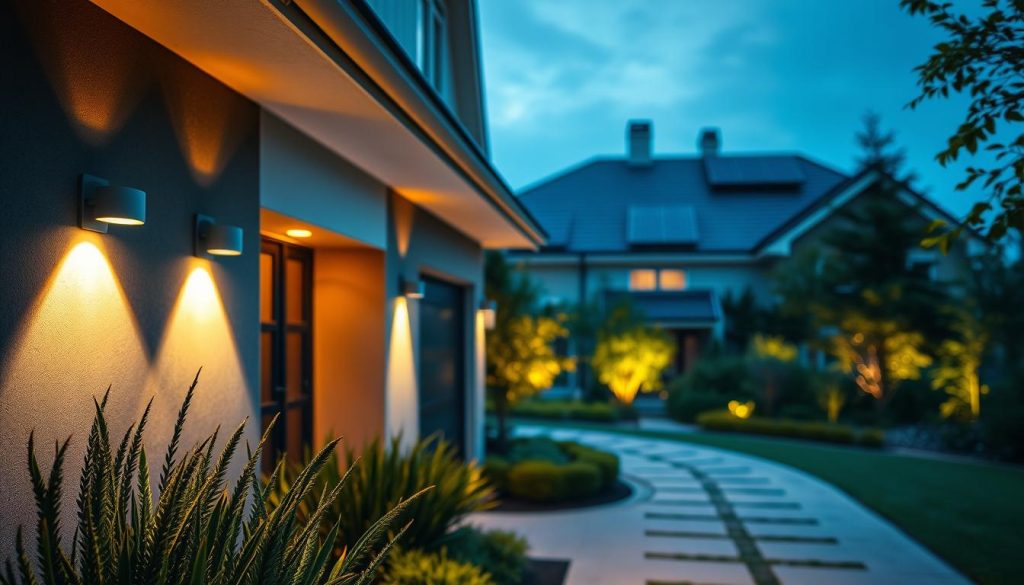
Motion-Sensor Options for Added Protection
Motion-activated solar lights add an extra layer of security. They startle intruders when they move. These lights use solar panels and sensors to detect heat and movement.
Place motion-sensor lights in these spots:
- Side yards and blind spots
- Areas near windows and entry points
- Driveways and property access points
- Detached structures like sheds or garages
Quality solar motion lights have adjustable settings. You can set them to avoid false triggers and ensure they turn on for people. The sudden light can scare off intruders, who prefer to stay hidden.
Solar security lights are great because they protect and beautify your garden at night. With the right placement, your garden will be safer and more stunning after dark.
Creative Design Ideas to Transform Your Outdoor Space
Solar garden lights are more than just lights. They let you express your creativity and change your outdoor space. By choosing the right spots and lights, you can make your yard magical at night. Let’s look at some ways to make solar lights a key part of your yard’s look.
Creating Magical Garden Ambiance
A magical garden needs layered lighting for depth. Start with path lights to guide the way. Then, add lights at different heights for interest.
For dining, hang solar lights from trees for a cozy feel. String lights overhead add a festive touch.
Think about the light color. Warm white lights are great for relaxing areas. Cool white lights make water features sparkle and plants glow like the moon.
Highlighting Landscape Features
Lighting can turn simple garden parts into highlights at night. Uplighting makes trees stand out with shadows.
For stone walls or sculptures, use grazing light to show texture. Solar spotlights let you aim light exactly where you want.
Water features shine with solar lights inside. Remember, what’s not lit is just as important as what is. Contrast and shadow add drama to your lighting.
Seasonal Decorating with Solar Lights
Solar lights change with the seasons. In summer, use color-changing stakes for fun. Solar orbs in pools add whimsy.
Fall is for amber lights that match the season. Place solar lanterns with pumpkins for a beautiful display.
Winter is for solar string lights on structures. Solar snowflake projectors create a dazzling display without cords.
| Lighting Technique | Best Garden Features | Recommended Light Type | Effect Created |
|---|---|---|---|
| Uplighting | Trees, tall shrubs, sculptures | Solar spotlights | Dramatic shadows, heightened dimension |
| Downlighting | Patios, seating areas, plants | Solar hanging lights | Natural moonlight effect, soft illumination |
| Grazing | Textured walls, stone features | Solar wall washers | Enhanced texture, architectural emphasis |
| Silhouetting | Plants with interesting shapes | Solar flood lights | Dramatic plant profiles against surfaces |
Why Solar Garden Lights Are the Smartest Choice for Modern Homeowners
Solar-powered garden lights are a smart choice for today’s homeowners. They turn outdoor spaces into beautiful nighttime spots without costing you a penny on electricity.
These lights do more than save money. They help the planet by cutting down on carbon emissions and avoiding battery waste. Plus, setting them up is easy, with no need for wiring or electricians.
Today’s solar lights can handle rain, snow, and sun well. They work reliably all year with little upkeep.
Solar lights are great for any garden design. They can light up paths, highlight plants, or create a magical evening feel. The possibilities are endless.
They also make your home safer. Bright exteriors scare off intruders and keep your family and friends safe.
As technology gets better, solar lights will too. Old problems like dim light and short battery life are fading away.
Want to light up your outdoor space? Start with a few lights or go big with a full plan. Solar lights are a green, easy way to meet today’s homeowner needs.

